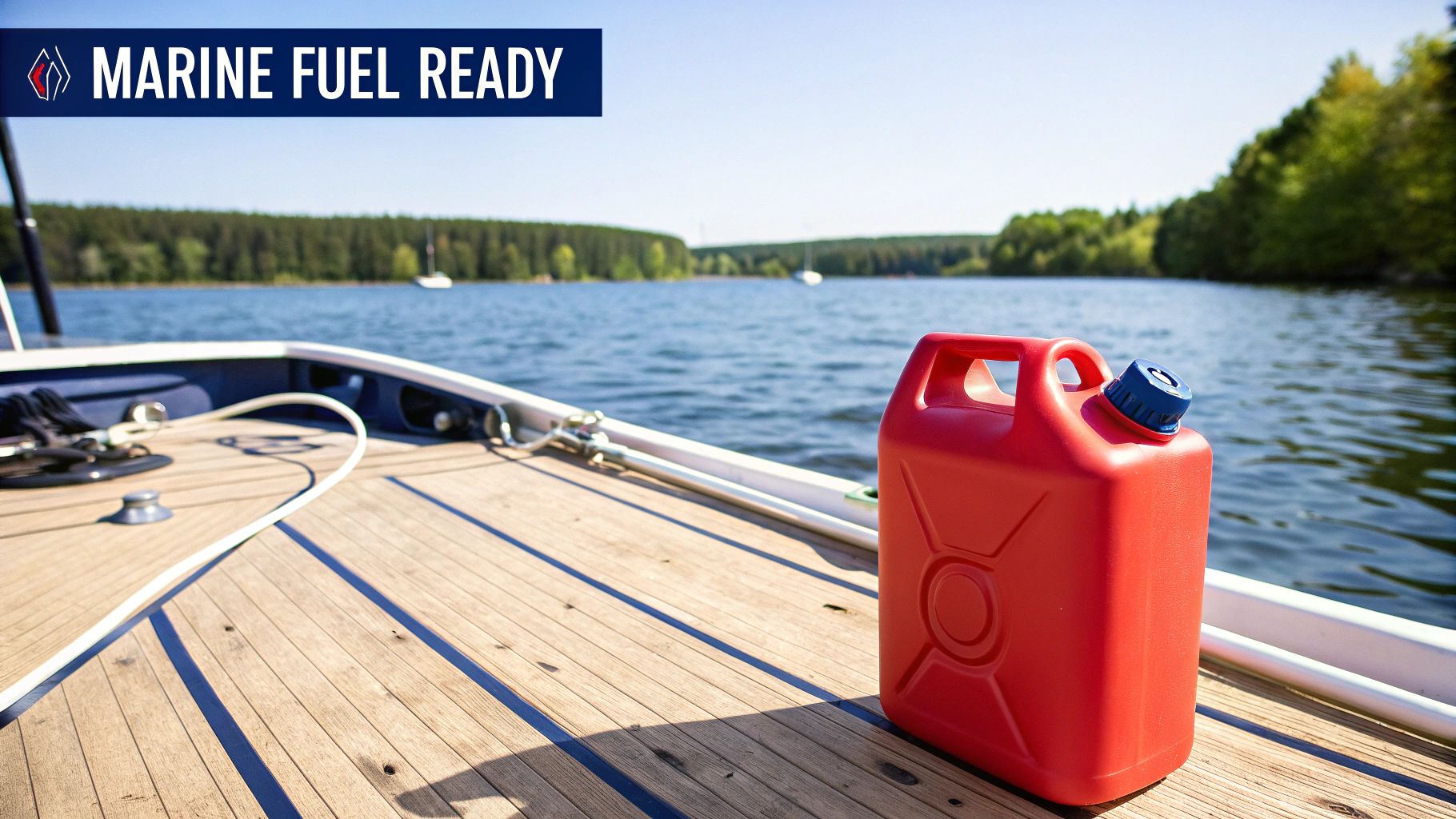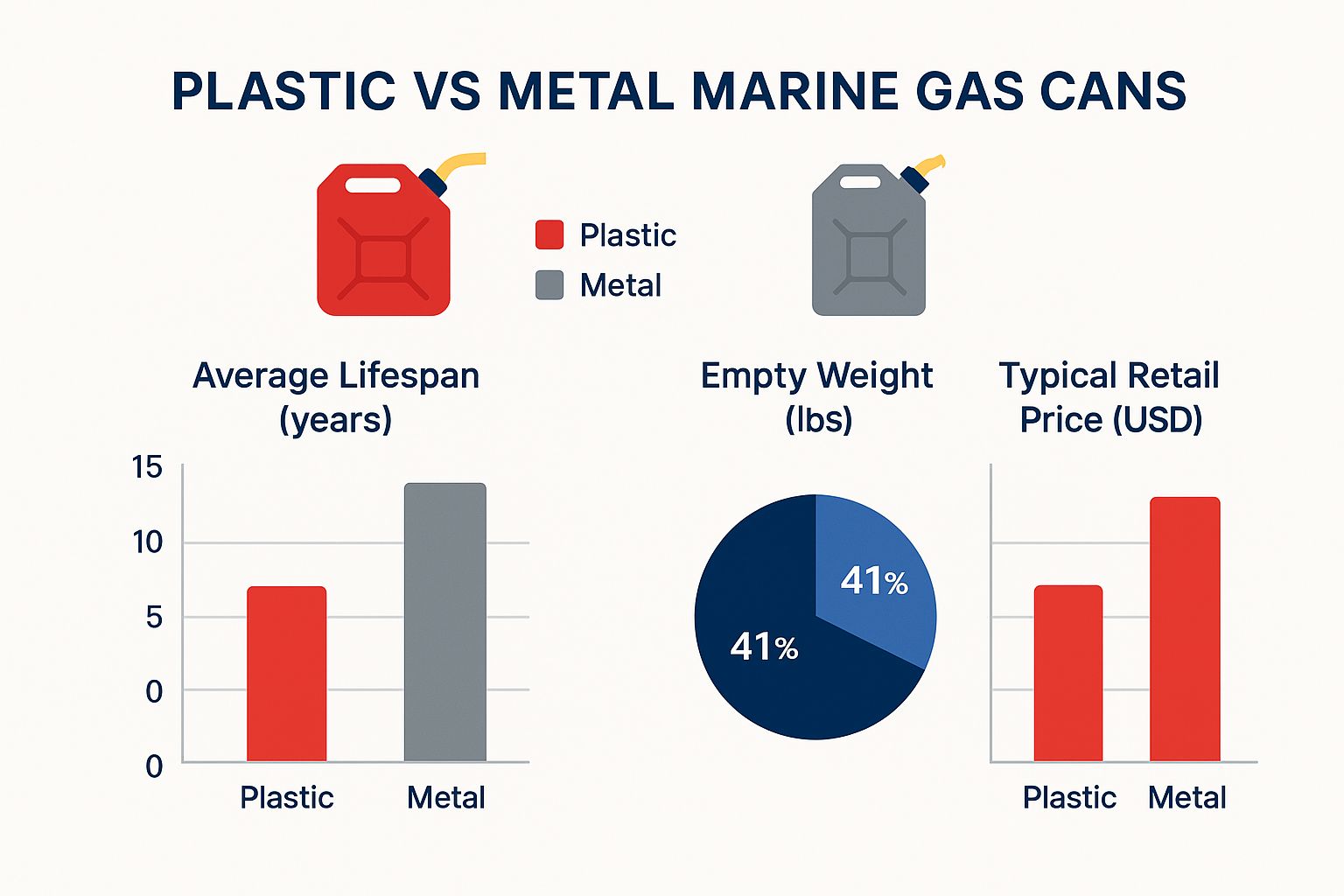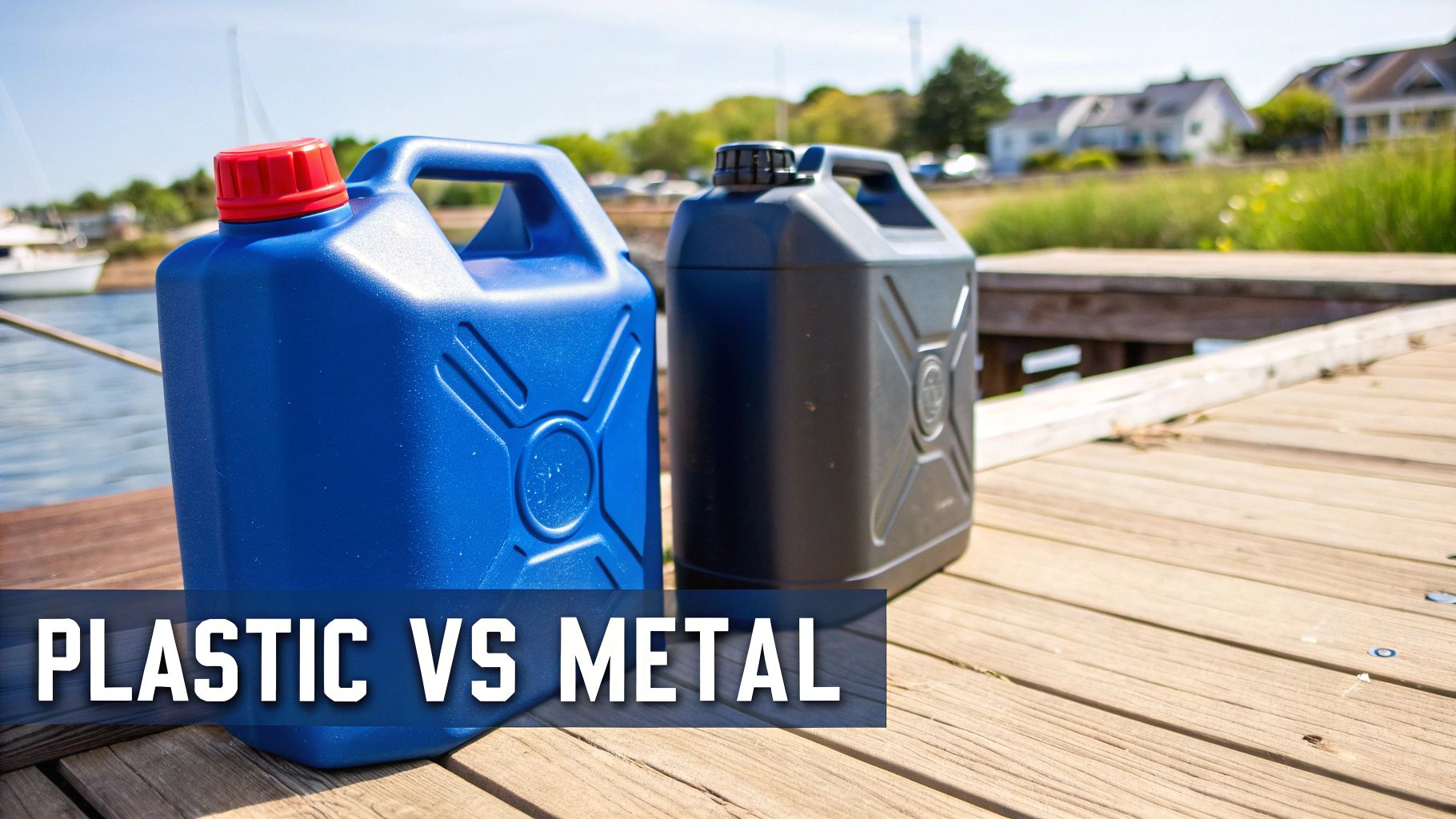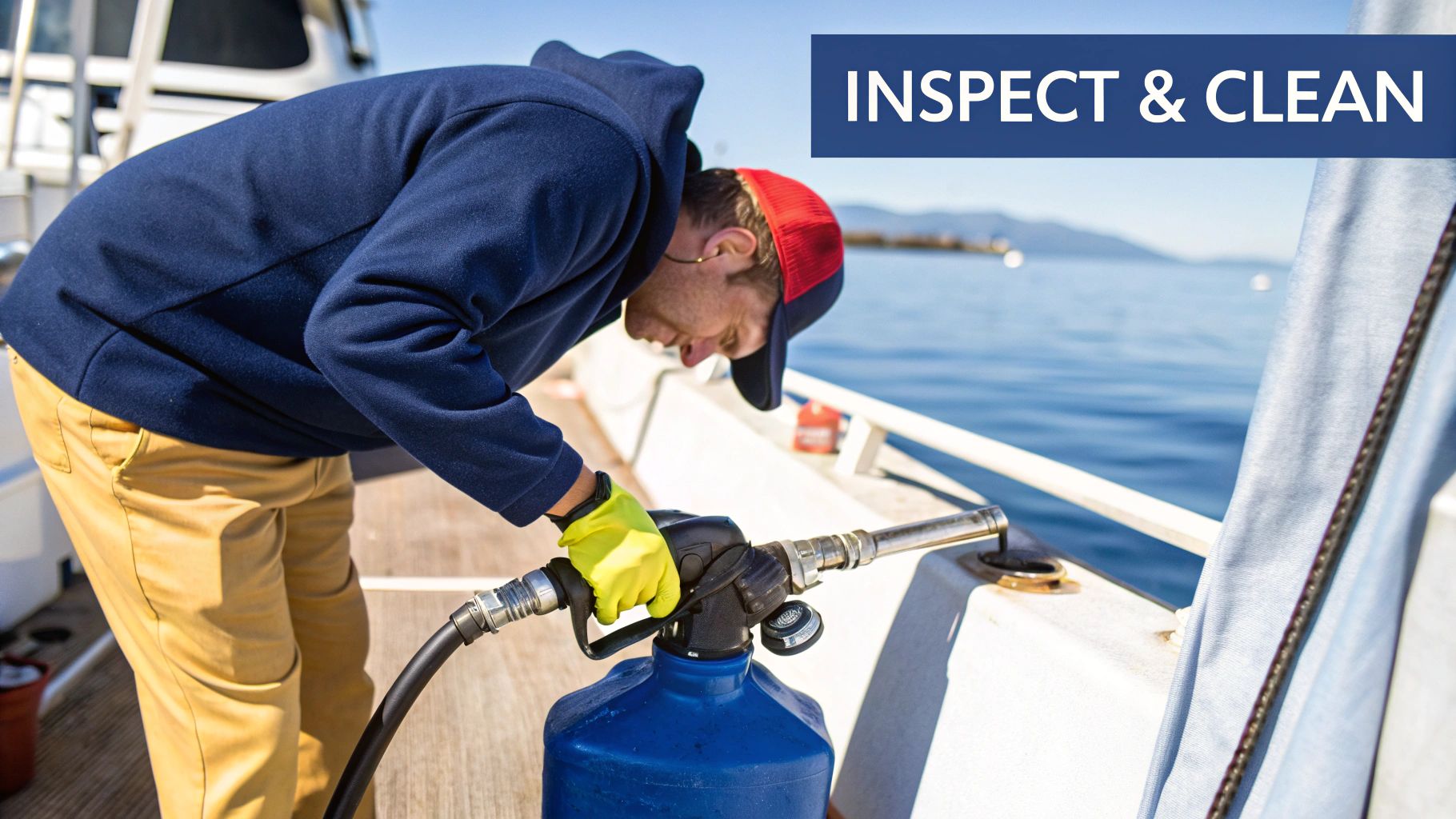Thinking about refueling your boat? That standard red gas can sitting in your garage won't cut it. You absolutely need a purpose-built marine gas can. These things are engineered to take a beating on the water—from relentless sun and saltwater spray to the constant rocking and rolling of your boat. For safety and pure reliability, they're non-negotiable.
Why Your Boat Needs a Proper Marine Gas Can

Think of it this way: a regular gas can is like a simple bucket. It gets the job done in a predictable place like your garage or shed. A marine gas can, on the other hand, is more like a professional diver's sealed toolkit—it's rugged, secure, and designed to perform under pressure.
The marine environment throws a unique set of challenges at your gear that a standard container just isn't designed for. The constant motion, corrosive saltwater, and intense UV exposure can break down a normal plastic can in no time, leading to cracks, leaks, and seriously dangerous fuel spills. A proper marine container is built from the ground up to resist these elements, making sure your fuel stays right where it belongs.
Built for a Harsher Environment
The real differences are in the design and materials. A marine gas can isn't just painted a different color; it's engineered to survive life at sea. These aren't just minor perks—they are critical safety features that protect you, your passengers, and your boat.
Here’s what really sets a marine can apart:
- UV-Resistant Materials: The plastic is specifically treated to stop the sun's rays from making it brittle and prone to cracking.
- Thicker Walls: They provide way more durability to handle the inevitable bumps and bangs that happen on a moving boat.
- Specialized Venting: Marine cans have vents designed to manage pressure changes from the fluctuating temperatures you get on the water, preventing a dangerous buildup of fuel vapor.
A marine gas can is built with the understanding that every single part, from the cap seal to the spout, has to hold up in conditions far more demanding than anything on land. It’s a specialized tool for a specialized job.
Handling fuel correctly is a cornerstone of boating safety, and it all starts with having the right equipment. You can learn more about how to store gasoline safely to round out your knowledge, but choosing a dedicated marine gas can is the first and most crucial step toward safe fueling for every single trip you take.
Comparing Marine Gas Can Materials and Designs
When you're out shopping for a marine gas can, one of the first decisions you'll face is the material. It's a bit like choosing between a modern fiberglass boat and a classic wooden one—both get the job done, but their construction gives them totally different strengths and weaknesses on the water.
The two main players in the game are high-density polyethylene (HDPE) plastic and good old-fashioned metal. Each has its own personality, and which one is right for you really depends on your boat, your budget, and how you plan to use it.
Plastic Versus Metal: The Great Debate
Let's start with HDPE, the material you’ll see most often these days. Its biggest selling point for boaters is that it’s completely immune to rust and corrosion from saltwater. That's a huge advantage right there. Plastic cans are also noticeably lighter, which makes lugging them down the dock a lot less of a chore. Plus, they can take a few bumps without denting.
On the other hand, you’ve got the traditional metal cans, usually built from tough-as-nails steel. These are the heavy-duty workhorses. Their main claim to fame is incredible durability. If you’re worried about punctures or rough handling, a metal can offers that extra peace of mind.
This image lays out the key differences you’ll find in terms of lifespan, weight, and what you can expect to pay.

As you can see, plastic gives you an affordable, lightweight option, while metal costs a bit more and weighs more but is built to last. For a closer look at specific products, our guide on the top boat gas cans is a great place to start.
To make the choice even clearer, let's break down the pros and cons side-by-side.
Marine Gas Can Material Comparison
| Feature | High-Density Polyethylene (HDPE) | Metal (Steel or Aluminum) |
|---|---|---|
| Corrosion Resistance | Excellent. Completely resistant to saltwater and rust. | Good, but can rust or corrode if scratched or dented. |
| Weight | Lightweight and easy to transport. | Heavier, which can make carrying it difficult. |
| Durability | Resists dents but can be punctured by sharp objects. | Extremely durable and puncture-resistant. |
| Cost | Generally more affordable upfront. | Higher initial investment. |
| Best For | Most recreational boaters, saltwater environments. | Commercial use, rugged conditions, long-term storage. |
Ultimately, the best material really boils down to your specific needs. If you’re a weekend boater who values convenience and corrosion resistance, HDPE is probably your best bet. But if you demand maximum durability for commercial or heavy-duty use, the resilience of a metal can is hard to beat.
Decoding Essential Design Features
Beyond just the material, the actual design of the can and its parts is what separates a great can from a frustrating (and potentially dangerous) one. These aren’t just bells and whistles; they’re engineered solutions for handling fuel safely on a moving boat.
Two of the most important features to understand are the flame arrestor and the venting system.
A flame arrestor is a simple but brilliant safety device. It’s a small screen, usually metal, located at the base of the spout. Its only job is to stop an external spark—say, from static electricity—from getting inside the can and igniting the fuel vapors. It’s a critical defense against a potential explosion.
Venting is another non-negotiable safety feature. As temperatures fluctuate, the fuel and vapor inside the can expand and contract, building up pressure. A proper vent lets that pressure escape safely.
- Self-Venting Spouts: Most modern, EPA-compliant cans have these. The spout is designed to automatically release pressure as you pour, which helps prevent spills and the release of fumes.
- Manual Vents: On older cans, you might find a small, separate screw cap for venting. You have to remember to open it before pouring to let air in, which ensures the fuel flows out smoothly instead of chugging and splashing.
Understanding Boating Fuel Safety Regulations

When you're handling gasoline on the water, safety isn't just a good idea—it's the law. The labels and certifications you see on a proper marine gas can aren't just for show. They're your proof that the container has passed a whole battery of tests from major regulatory bodies. Knowing what they mean is key to staying safe and on the right side of the law.
Think of these rules as the official playbook for carrying fuel on a boat. There are two main players setting the standards: the U.S. Coast Guard (USCG) and the Environmental Protection Agency (EPA). Each one tackles a different piece of the safety puzzle, and a truly compliant can has to satisfy both.
The Role of the U.S. Coast Guard
The USCG's main job here is to prevent fires and explosions on your vessel. Simple as that. A gas can that’s USCG-approved has been built and tested to handle the uniquely tough marine environment. This is about more than just being sturdy; it’s about making sure fuel stays contained, no matter what.
A USCG-approved can must prove it can handle:
- Puncture Resistance: It has to be tough enough to not get pierced if it gets knocked around in transit.
- Drop Testing: The can must survive a fall onto a hard surface, like a dock or boat deck, without cracking or leaking.
- Leak-Proof Seals: Its cap and spout have to form a perfect seal, preventing both liquid fuel and dangerous vapors from escaping.
If a can doesn't have that USCG stamp of approval, it simply hasn't been proven safe for a boat in motion, where even a tiny leak can turn into a disaster.
EPA Standards for Environmental Protection
While the Coast Guard is worried about keeping your boat from going boom, the EPA is focused on protecting the air and water from pollution. An EPA-compliant marine gas can is specifically designed to stop harmful gasoline vapors—known as volatile organic compounds (VOCs)—from escaping into the atmosphere. This is the main reason why modern gas cans are so different from the old ones we grew up with.
The heart of EPA compliance is all about vapor control. These rules require features like automatic shut-off spouts and special permeation-resistant materials to keep fumes locked inside, which protects the environment and your own health.
These environmental rules are part of a massive global effort to clean up maritime activities. Just look at the marine gas oil market, which is expected to hit USD 45 billion by 2035, largely because of new regulations that demand cleaner-burning fuels.
Keeping up with these standards is a must for any boater. For a closer look at this topic, our guide on environmental compliance training offers some great insights. When you choose a can that meets both USCG and EPA standards, you're doing more than just following rules—you're making a smart investment in the safety of your passengers, your boat, and the water you love.
How to Select the Right Marine Gas Can

Picking the right marine gas can isn’t about finding a single "best" option. It's about finding the one that’s right for your boat and how you use it. Think of it like buying an anchor—the one you'd use for a small dinghy on a calm lake is completely wrong for an offshore cruiser. The same logic applies here.
The best choice comes down to a few practical questions. How far do you usually go? What kind of water are you on? Answering these honestly will lead you to a can that’s not just legally compliant, but actually safe and convenient for your specific setup.
Matching Capacity to Your Vessel
The first thing to nail down is capacity. While it’s tempting to grab the biggest can you can find to cut down on refueling trips, bigger isn't always better. A full, sloshing 6-gallon can might be manageable on a stable dock, but it can quickly become a clumsy hazard on a small, rocking boat.
Here’s a quick way to think about matching size to your boating style:
- 1–3 Gallons: These are perfect for smaller craft like dinghies, jon boats, or jet skis. They’re lightweight, easy to handle, and carry just enough reserve fuel for shorter outings.
- 5–6 Gallons: This is the sweet spot for most recreational boaters. It’s a great fit for day cruisers and mid-sized fishing boats, offering a solid fuel reserve without being too bulky or heavy to store securely.
Spout Design and Usability
Let's be honest: modern EPA-compliant spouts can be frustrating. They’re designed to be “spill-proof,” which often means you have to push, twist, or press a button just to get the fuel flowing. While these designs are great for preventing spills and vapor release, they can make the whole refueling process feel slow and awkward.
Older, simpler spouts were definitely faster, but they lacked these critical safety features. When you’re shopping for a new marine gas can, try to get a feel for the spout mechanism before you buy. Some are far more user-friendly than others, and finding one you can operate confidently will make a huge difference out on the water.
Choosing the right fueling gear is a small but vital part of a much bigger picture. The entire global shipping industry—a market projected to hit USD 171.5 billion by 2030—runs on the same principles of safe and reliable fuel transfer. Your choice reflects that same commitment to safety and efficiency. You can find more insights on the global marine fuel market on knowledge-sourcing.com.
At the end of the day, you want a can that feels like a natural part of your boating gear. It should be easy to carry, simple to secure, and straightforward to use. By thinking through your boat’s size, your fuel needs, and the spout design, you can pick a marine gas can that will serve you well for many seasons.
Best Practices for Handling Fuel on Your Boat
Having the right marine gas can is a great start, but knowing how to handle it safely is what keeps you out of trouble on the water. Managing fuel isn't rocket science, but it does demand a bit of care and a consistent routine. Getting this right protects you, your passengers, and your boat from the very real dangers of gasoline.
If you remember only one thing, make it this: never fill a portable gas can while it's inside your boat. Period. Always take it out and place it on the dock before you even think about putting a nozzle near it.
This one simple action does two critical things. First, it prevents static electricity from building up and creating a spark. Second, and maybe even more importantly, it ensures that if you do have a little spill, it happens on the dock—not in your boat's bilge, where fumes can collect and become a ticking time bomb.
Securing Your Can for the Ride
Once it’s full, you need a plan for stowing that gas can. A loose can sliding around on deck is a serious hazard. When your boat starts rocking and rolling, a tipped-over can could easily turn a perfect day into a dangerous, fuel-soaked mess.
Your main goal here is to stop it from moving at all. Here’s how you do it:
- Find a Good Spot: Locate a place on your boat where the can fits securely, ideally on deck. Make sure this spot has plenty of ventilation so any fumes can blow away harmlessly.
- Strap It Down: Use bungee cords, heavy-duty straps, or a rack built for the job. You want that can held so tight it won't shift an inch, even when you hit a big wake.
- Keep It Upright: This sounds obvious, but always store the can standing up. It helps prevent any sneaky leaks from the cap or vent.
- Stay Away From Heat: Keep the can far from your engine, exhaust, and any long-term direct sunlight. Heat causes pressure to build up inside, and that’s something you want to avoid.
Fueling Up Without the Fuss
When it's time to pour fuel from the can into your boat’s tank, a little technique goes a long way. If you rush it, you risk spills and static sparks—the two biggest no-nos when handling gasoline.
The trick to avoiding a static spark is all about constant contact. Keep the spout of your gas can pressed firmly against the metal fill pipe of your boat’s tank the entire time you're pouring. This grounds everything and stops a static charge from building up.
Remember to pour slowly. Listen for the sound to change as the tank gets close to full—this is your cue to stop before you overfill. A good, clean funnel can also be your best friend here, especially if the water is a bit choppy.
The Boater's Rule of Thirds
Finally, smart fuel handling is also about smart fuel planning. There’s an old principle every seasoned boater lives by: the "rule of thirds." It’s a simple guideline that will keep you from ever getting stranded.
- Use one-third of your fuel to get to your destination.
- Use one-third of your fuel for the trip back.
- Keep the final one-third in reserve for emergencies. Think unexpected weather, strong currents, or just deciding to explore a little longer.
Following this rule gives you a comfortable safety cushion every time you leave the dock. When you combine secure storage, careful pouring, and smart planning, you’re setting yourself up for a safe and worry-free day on the water.
Frequently Asked Questions About Marine Gas Cans
Even after you've got the basics down, you'll still run into questions out on the water. It happens to everyone. This section tackles some of the most common things boaters ask about, giving you quick, straightforward answers to clear up any confusion.
Can I Use a Regular Red Gas Can for My Boat?
Let's cut right to the chase: absolutely not. That standard red gas can you use for your lawnmower has no place on a boat. It's just not built for the job.
Think about it—your boat is constantly exposed to sun, salt, and motion. Regular cans aren't made with UV-resistant plastic, so they can get brittle and crack after a season in the sun. They also lack the right seals and venting to handle saltwater corrosion and the constant pressure changes from temperature swings on the water. Using one isn't just a bad idea; it's a serious safety risk and could get you in hot water with the U.S. Coast Guard.
How Often Should I Replace My Marine Gas Can?
There isn't a hard-and-fast expiration date on a marine gas can, but they don't last forever. The best approach is to give your cans a good, honest look at the start of every boating season and before any long trip.
You’re looking for any signs that the can is giving up the ghost:
- Plastic Cans: Check for fading from the sun, any brittleness, or small cracks. Pay close attention to the seams and around the handle.
- Metal Cans: Look for any rust, deep dents that might weaken the structure, or worn-out seals on the cap and spout.
As a rule of thumb, if you spot any leaks, damage, or signs of the material breaking down, replace it immediately. No exceptions. Many experienced boaters just make it a habit to replace their plastic cans every 3-5 years to stay ahead of any potential problems.
What Is the Best Way to Store a Gas Can in the Off-Season?
Storing your gas can correctly over the winter is all about safety and keeping your fuel fresh. The best thing you can do is run the remaining fuel through an engine. If that's not an option, pour in a quality fuel stabilizer to keep the gas from degrading.
Once the fuel is treated, store the can in a well-ventilated spot away from your house, like a detached shed or garage. It’s absolutely critical to keep it far from any ignition source—that means furnaces, water heaters, pilot lights, you name it. And never, ever store a fuel can inside a shrink-wrapped boat; the fumes can build up and create a massive fire or explosion hazard.
Why Are New Marine Gas Can Spouts So Hard to Use?
If you've bought a new marine can lately, you've probably wrestled with the spout. They’re a lot more complicated than the old ones, and that's by design. The EPA brought in new rules to cut down on fuel spills and vapor emissions.
These new "spill-proof" spouts usually require you to push, twist, or hold down a lever just to get the fuel flowing. It's a system that’s great for preventing spills and trapping fumes, but it can be a real pain to use, especially when you're in a hurry. It just takes some practice. Here's a tip: try it out a few times with an empty can to get the hang of it before you’re trying to manage a full, heavy can on a wobbly dock.
Ready to make every refueling stop quick, clean, and completely stress-free? CLiX Fueling Solutions offers an automatic shut-off system that prevents dangerous and costly fuel spills before they happen. See how you can protect your boat, the environment, and your peace of mind by visiting the CLiX Fueling website today.












